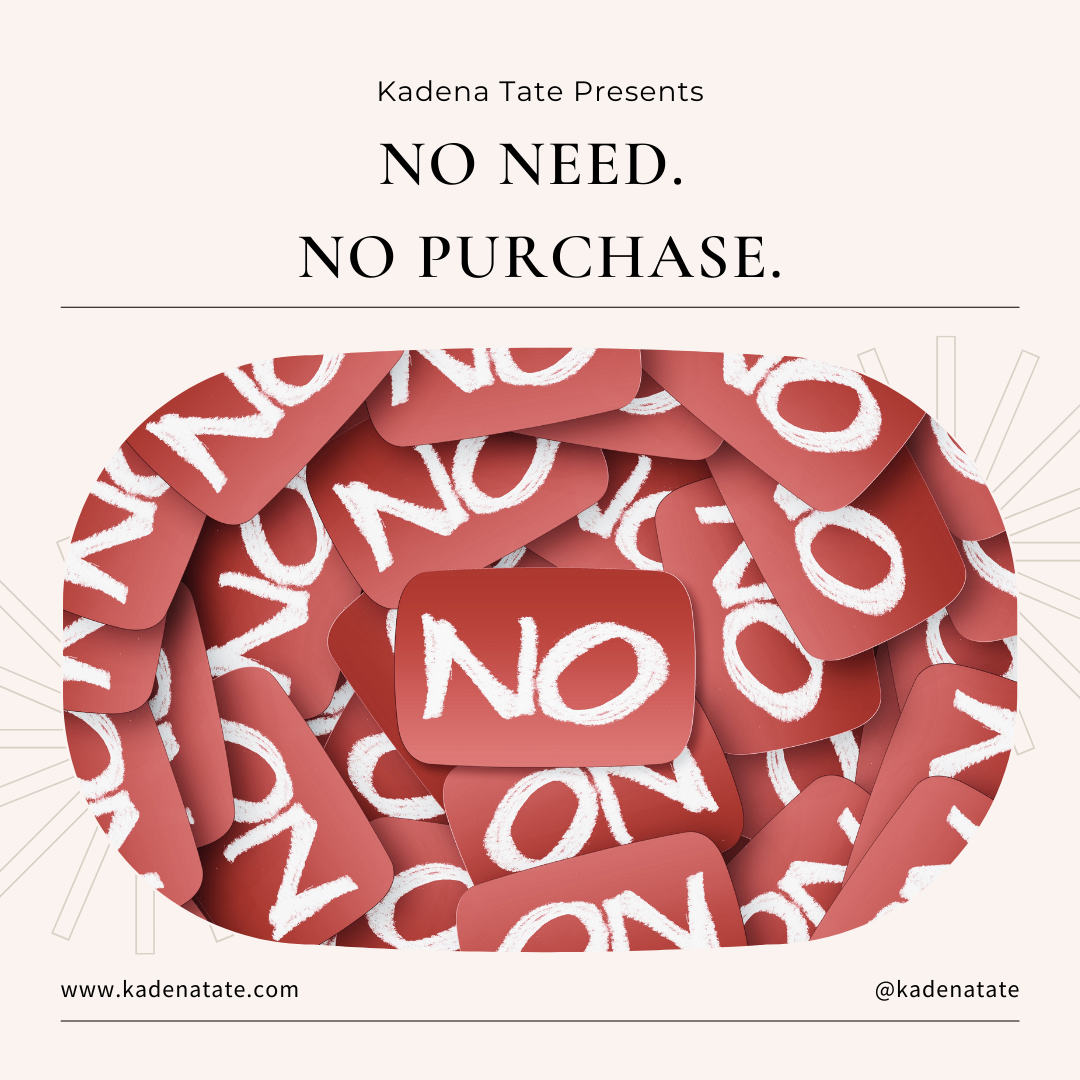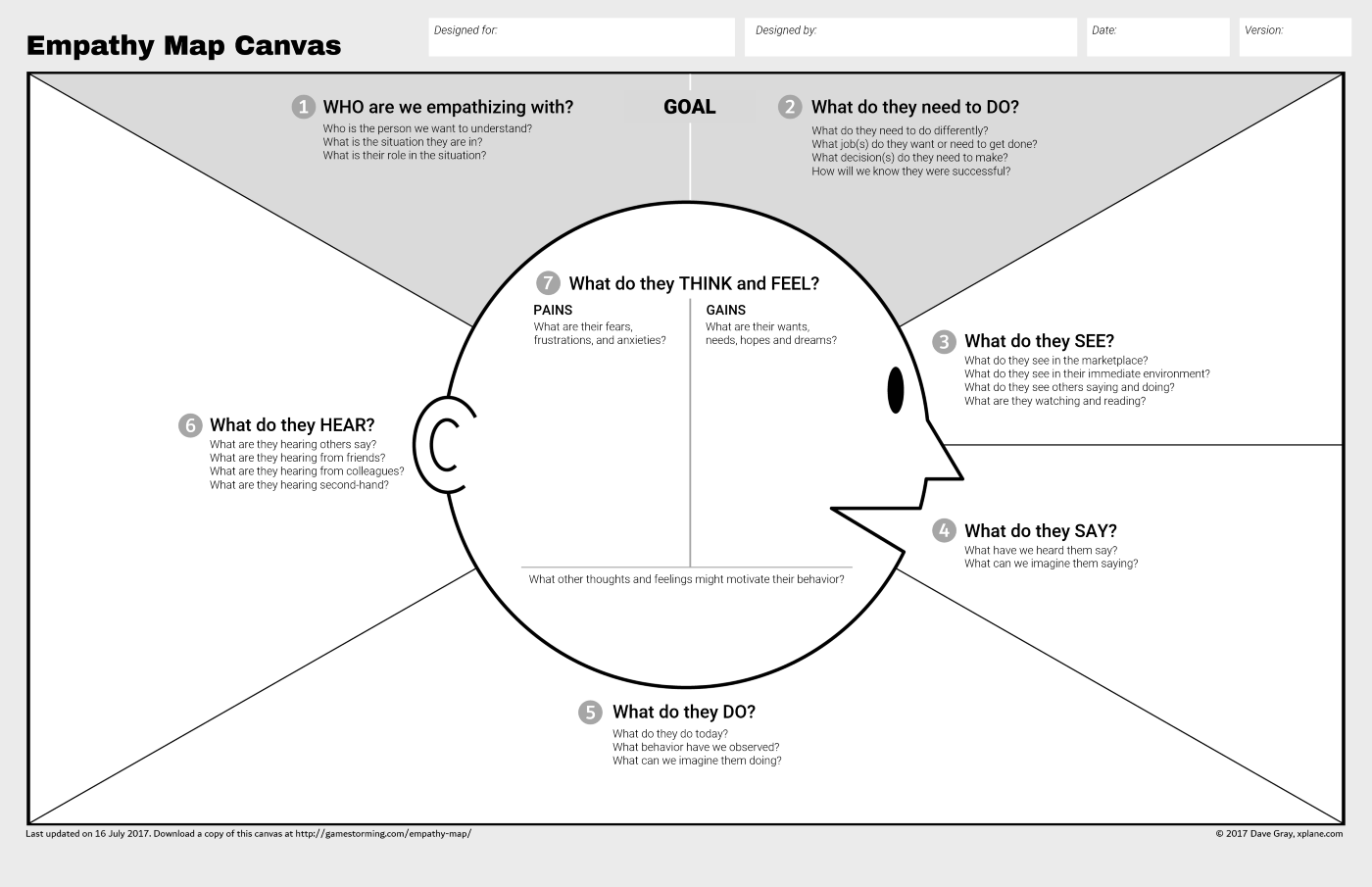No Need. No Purchase.
Entrepreneurs are paid to help clients solve problems and overcome challenges. They may be simple or complex. The most important thing to remember is that without a need, there will not be a purchase.
Sales are born from desire. Desire is triggered by internal or external stimuli. The desire may be fueled by a desire to become the best versions of themselves or they happen because the client’s coping mechanisms are not working.
Keep in mind that people will never hire you if you hurl judgment, criticism, sarcasm, guilt and shame on them. They have enough problems without you trying to make them feel small and insecure.
Heal yourself so that you can light the way for others. Trust me when I tell you that empathy and compassion will lead to higher sales and raving fans.
USE A BUYER EMPATHY MAP TO UNCOVER BUYER NEEDS
Dave Gray is the founder of XPLANE and author of Gamestorming. He designed the Empathy Map many years ago, as part of a human-centered design toolkit. This empathy map helps teams develop deep, shared understanding and empathy for other people. People use it to help them improve customer experience, to navigate organizational politics, to design better work environments, and a host of other things. For our purposes, we shall use it to strengthen our buyer personas and customer journey maps.
First of all, please use one canvas per customer segment, in order to have clarity around who you are empathizing with.
What do they need to do? Yes, I understand that phrases like “need to” or “should” are rooted in outside authority, however there are moments where we need to shift out of and away from toxic mindsets and behaviors. No worries, you are not to going to boss anyone around. You simply need clarity around what they need to do differently or stop doing altogether, in order to achieve their desired result.
Describe what your ideal customer sees in their environment:
-
What do they see in their personal and professional life? Are they happy, bored or sad when it comes to living + working in the same place surrounded by the same people?
-
What do they see while surfing online? Are they looking at job ads, shopping, watching Netflix and YouTube, watching porn, reading social media posts or reading ebooks?
-
What do they see while out and about? i.e. When I was a real estate broker, I noticed that the pen that most businesses use when they give you the credit card slip to sign, would be a great advertising opportunity for me. I asked every single establishment if I could become their pen supplier. Of course they said “yes”, because this expense was now covered by me. I paid for very nice pens to ensure that customers “stole” them. It makes me smile every time I get a call from someone who “stole” my pen 10 years ago!
-
Who are the key people in their environment? Family, friends, work colleagues, associates? If this person has influence, they have the ability to support your efforts to reach a larger audience.
-
What kind of offers are they exposed to? Fee based or complimentary? Individual or group experiences? The more familiar someone is with a specific approach, the clearer you need to be about how you do things differently than someone with a similar offer.
-
What problems do they face? Are they emotional, spiritual, physical or financial? There are many problems that can be solved without the aid of a therapist or licensed professional. For example, many home based entrepreneurs at times feel isolated and lonely. Online and offline events, meetups, retreats and conferences shift them out of this energy.
-
What do they see in the online marketplace? I don’t know about you, but Etsy, Creative Market, Creative Live, and Amazon have some of the coolest products ever!
-
What do they see others saying and doing? Do they see people “going along to get along”? Do they see others standing up and speaking out? Do they see others hiding their true voice and/or talents for fear of criticism, rejection or attack?
-
What are they watching and reading? This information is pertinent if you desire to advertise in digital or physical television or in magazines.
-
What do they see when traveling? Do they prefer to drive, fly, or sail? Do they prefer to dine or shop? Do they prefer the ocean, beach, mountains, forest or city? Do they prefer to travel in First class, Business Class or Economy class?
Imagine what your ideal customer would say in public or private:
-
What have we heard them say? Are their words filled with positive expectancy or the opposite?
-
What can we imagine them saying? Which movies, cars, restaurants, products, , services and travel destinations do they talk about?
-
What do they say matters to them? For example, do they say that relationships are important, yet, never take the time to learn how to communicate and build intimacy?
-
What are the differences between what they say and what they think? Do they say “yes” out of guilt and obligation?
Describe what your ideal customers do:
-
What did they do today? Did they spend their time delightfully engaged in their personal or professional endeavors?
-
What behavior have we observed? Do they find it difficult to honor their commitments due overwhelm?
-
What can we imagine them doing? Are they waking up at 5am to workout? Are they cooking healthy and nutritious foods?
-
Do they influence anyone? Are they speaking words that lift people up or the opposite?
-
How do they behave in private versus in public? Are they comfortable in their own skin or still walking around as “The Great Pretender”?
Describe what your ideal customers hears in their environment:
-
What are they hearing from family, friends, and colleagues? Are the words encouraging and supportive or the opposite? For example, when I worked in the international aviation industry, one of my co-workers said to me “Why are you going to college? This is a good job paying $25 an hour. College is a waste of your money. Look at all of these college graduates driving cabs.” I remember smiling inwardly and thinking to myself “There is no way I am allowing your negative attitude to spill over into my life.” I literally skipped to classes that day.
-
What are they hearing second-hand? Are they listening to factual information, fake news or gossip?
-
What are they hearing others say? Is it educational and entertaining or fear based rhetoric?
-
Who are their main influences? How are they influenced? Through what means? I remember being in a Starbucks once, and asking the barista for the name of this song that was playing because it was so beautiful. I immediately went to iTunes and downloaded the album. His name is Damien Escobar, and the album is “Sensual Melodies.” I then googled him and was stunned to discover that he was going to be playing in Dallas two weeks later. Bought the concert tickets and also followed him on Facebook, Instagram and Twitter.
-
What are they listening to on the radio? Do they prefer music or talk radio? If they love talk radio, what topics are of interest to them?
Try to outline what is in the mind of your customer:
-
What really matters to them (and what they do not say)? Are their needs being met or ignored? Do they feel seen, heard, and understood?
-
What moves them? Which philanthropic endeavors light them up? What makes them angry? What are their passions and guilty pleasures?
-
What are their dreams and aspirations? Do they want to start a new business, sell an existing business, send their children to college, retire with a million dollars, pay off their home, purchase a new car, purchase a new wardrobe, lose weight, and/or meet their life partner?
-
What are their concerns? Are they fearful that they cannot earn enough money to meet payroll or take care of their financial responsibilities? Are they in a caregiver role? Do they feel as though life is a pleasurable or painful experience?
Think about what concerns your customer:
-
What really concerns/frustrates them? Is the problem related to health, relationships, career, or money?
-
What obstacles do they encounter to reach their goals? Is it an addiction, unsupportive spouse, family and friends or demanding supervisor?
-
What risks do they have to assume? Are they terrified of intimacy? Do they live and work in a “safe” environment? Do they face occupational hazards?
Think about the motivations of your customer:
-
What do they really want or need to achieve? In what are of their lives are they in need of peace of mind?
-
How do they measure success? Is it tangible or intangible?
-
How do they try to achieve success? Are they looking for shortcuts or are they willing to show up, tell the truth, and do the work?
Ladies, studying your ideal clients on an intimate level, provides an understanding of who she is, where she comes from, and how she might be dissatisfied with the status quo. Their past experiences may or may not directly impact why they choose to work with you, but they do give you and idea of what they're up against before they decide to work with you.
INQUIRY
What was your biggest AHA moment after using the Empathy Map Canvas?
This blog post was updated 6 February 2018.

